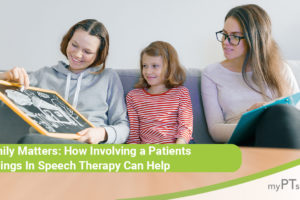The process of evaluation and development of a speech intervention plan can be an intimidating experience for families. So much so that parents often experience the temptation to rely on the therapist to fix the child’s speech problem. However, when parents make an attempt to understand their child’s diagnosis and become active participants in the intervention process, the child, the parents, and the speech therapist benefit. Parent involvement is key to helping child patients.
Parental involvement with positive reactions can turn to positive gains in child development. Speech pathologists can provide parents with multiple tools within five strategy categories. Furthermore, therapists can incorporate these tools into everyday routines. The five strategy categories follow.
How to Improve Parent Involvement in Speech Pathology
Quantity-Based Strategy
As a speech therapist, you are likely aware that you can teach parents to be intentional with the amount of language they use with their children. However, have you considered the diversity of vocabulary and input complexity? An awareness of these factors facilitates the child’s acquisition of new vocabulary and more extended, complex expressions. Consider increasing complexity by adding words or word endings that provide additional grammar or meaning.
Responsive Strategies
The emphasis of this strategy is the child’s interests and use of language. This strategy also includes how the adult’s language may vary in response. General responsiveness to the child’s communication efforts is crucial. This category also includes additional strategies, including imitation, expansions, extensions and recasts. An extension is accomplished by maintaining the topic and adding the information.
Directive Strategies
Giving instructions or eliciting responses with various levels of support are directive strategies. Follow-in directives are those instructions related to the child’s focus of attention. Other directives result in a change in the direction of attention, including open-ended questions, choice prompts or say prompts. Choice prompts give children options, expecting them to respond in a particular way, possibly with a verbal response or a gesture.
Multimodal Strategies
Multimodal strategies enhance verbal communication by adding non-linguistic information with tactile or visual cues. The tactile cues might include touching a child when you call their name to elicit attention or using a touch cue on their face while associating it with a target sound or word. Additionally, visual cues include using gestures or signs in conjunction with verbal information.
Engagement-Based Strategies
Research that shows an association between engagement and language learning is the foundation for engagement-based strategies. Approaches might include positive affect, joint book reading, contingent play, child-directed interaction without much direction from adults, and environmental arrangement. Also, this is something where a patient’s siblings can be involved in as well as the parents.
Ready For A New Speech Pathology Opportunity?
Are you a speech therapist wanting a new challenge? Take a look at myPTsolutions to learn more about the open opportunities and advance your speech therapy career today.



